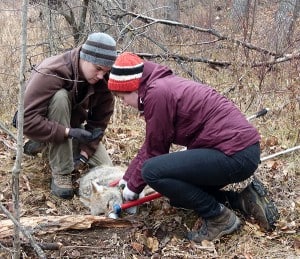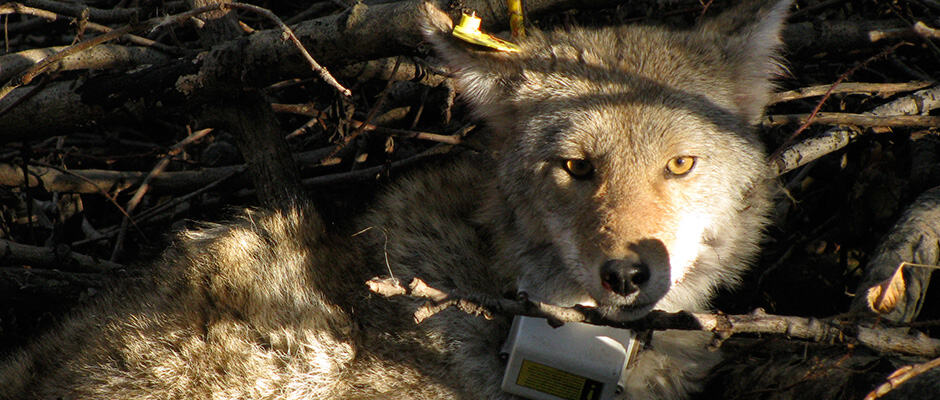Share this article
Mange Might be Causing More Coyote-Human Interactions
Coyotes living with mange, a contagious skin disease that’s identified by thinned out hair especially on their tails, are more likely to be drawn to human food and other anthropogenic resources, according to a new study published in Proceedings of the Royal Society B.
This might help explain a recent increase in coyote (Canis latrans) sightings and coyote-human conflicts in a number of places across North America including Canada, according to Maureen Murray, a researcher for the Edmonton Urban Coyote Project at the University of Alberta and the lead author of the study.

Researchers Maureen Murray and Joe Abercrombie collar a coyote. The researchers tracked 19 coyotes to find their home ranges and other data to determine the likelihood of the animals coming in contact with humans.
Image Credit: Natalia Lifshitz
“The goal of the study was to figure out why certain coyotes use human resources more than others,” Murray said. “A lot of coyotes tend to avoid people, but a disproportionate amount of conflicts seem to be caused by a few individual animals.”
Murray and her research team in Edmonton, Alberta tracked and collared 19 coyotes in the city. They then noted each coyote’s age, gender and whether or not it had been infected with Sarcoptic mange (Sarcoptes scabei), a disease commonly found in coyotes that causes skin legions, intense itching and hair loss.
Past research showed younger coyotes might use more resources related to humans since they might be naïve or unable to hunt, Murray said. Other studies suggested that male coyotes were more likely to prey on livestock. However, this research team had another idea. “We thought sick or injured coyotes might be more likely to seek out easy sources of food,” Murray said.
The researchers tracked the coyotes for four months making note of where the coyotes’ habitats were (residential areas or natural parks), their home range sizes, and their roaming behavior. They also collected hair samples from the coyotes after collaring them to determine the amount of carbon they were consuming over the past several months through stabilized isotope analysis. Higher levels of carbon in the animals suggests a large amount of corn consumption, which they are most likely getting from corn starch in human food, Murray said.
By analyzing GPS data as well as hair samples, the research team found that coyotes that were infected with mange were more likely to use anthropogenic resources. They tended to have a larger range of movement, showed more activity during the day, and ate food that was left over by humans.
“It seems like they are seeking out easy food sources like piles of garbage or compost, perhaps because they are stable in time and space and they can reuse them multiple times,” she said. “It leaves us with an interesting question: Does consuming anthropogenic sources make them sick, or are they using them because they are sick?” (Murray is currently working on a few studies to help answer that question.)
The research team hopes their work will help wildlife managers control human-coyote conflicts by reducing the number of infected coyotes. Current measures to manage mange include rubbing an ointment on the infected animal’s skin, which, according to Murray, is a difficult way to manage coyote populations in the wild.
Managers could also eliminate sources of food that attract coyotes into residential or other areas that might encourage disease transmission, according to Murray. “Treating mange could help, but based on our evidence, we are pushing to prevent the cycle before it starts,” she said.
Header Image:
A coyote sports a GPS tracking collar as part of a study to determine what characteristics make coyotes more likely to use anthropogenic resources. They found that mange — a disease commonly found in coyotes — resulted in increased human-coyote interactions.
Image Credit: Maureen Murray








